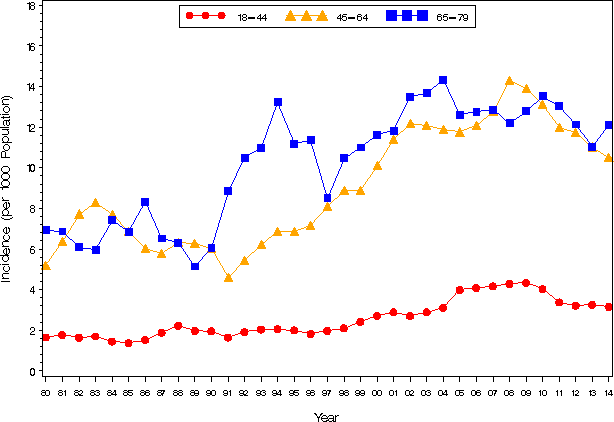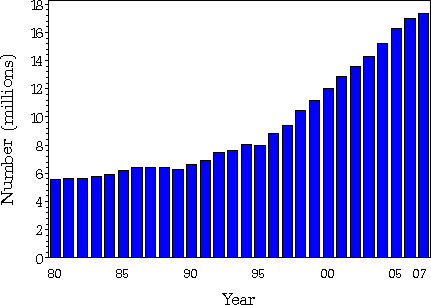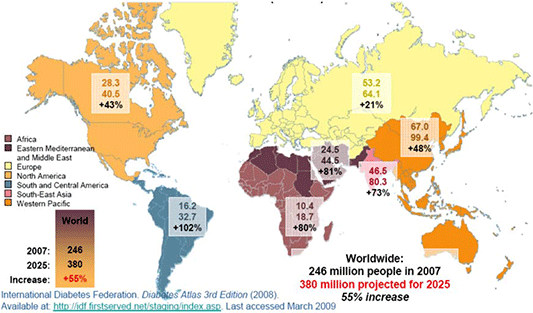Unfortunately, diabetes has become a common disease in the United States and worldwide. About 9% of Americans have DM, and 90% to 95% of them have type 2 diabetes (ADA, 2015). Americans living in poverty are more likely to have diabetes than middle-class and affluent Americans. Diabetes has also been correlated with obesity, creating a new term among healthcare professionals called “diabesity.” Alarmingly the trend is increasing each decade in our country, with a higher incidence of both diabetes and obesity that is projected to worsen. With current trends of obesity and metabolic syndrome, by the year 2030, 1 in every 3 people will develop diabetes mellitus (Wild et al., 2004).
Percentage of U.S. Population with Diagnosed Diabetes, 1980–2014

Source: CDC, 2015.
As shown in the above graph, from 1980 through 2014 the percentage of the civilian, non-institutionalized population with diagnosed diabetes mellitus increased by:
- 200% (from 0.6% to 1.8%) for those aged 0–44 years
- 124% (from 5.5% to 12.3%) for those aged 45–64 years
- 127% (9.1% to 20.7%) for those aged 65–74 years
- 126% (8.9% to 20.1%) for those aged 75 years and older
In general, the percentage of people with diagnosed diabetes has increased among all age groups. In 2014 the percentage of diagnosed diabetes among people aged 65 to 74 (20.7%) was more than 11 times that of people younger than age 45 (1.8%). It has been said 80% of people older than age 75 will eventually develop DM due to pancreatic fatigue and the prevalence of obesity. The number of Americans with diagnosed diabetes has more than tripled from 5.5 million in 1980 to 22 million (CDC, 2014). Looked at pragmatically, that becomes job security for you as a healthcare professional!
Prevalence of Diabetes by Year

Source: Advanced Adrenal Education, 2011.
Worldwide Prevalence of T2DM
Diabetes is increasing dramatically throughout the world. As countries become industrialized, with less manual labor, their populations become more sedentary and people eat a higher calorie Western diet, which fosters the development of type 2 diabetes. More than 3% of the world’s population has been diagnosed with diabetes, with the highest concentrations in developed countries.
Prevalence of T2DM Across the World

Prediabetes and Metabolic Syndrome
Due to the burden of rising numbers of people with DM, more attention has been directed at preventing the disease. In efforts to screen for diabetes, millions more individuals are being identified as having prediabetes, which presents as higher-than-normal blood sugar levels—but not quite high enough to diagnose as diabetes mellitus. A normal fasting blood sugar is 60 to 100 mg/dL. Diabetes is diagnosed by a fasting blood sugar >125 mg/dL. Prediabetes, or impaired fasting glucose, is diagnosed by a fasting blood glucose >100 mg/dL and <126 mg/dL. The prevalence rose dramatically from 27% in 2000 to 34% by 2010 (Abraham & Fox, 2013). It is estimated that 19% of Americans currently have prediabetes, which is 86 million Americans age 20 and older, and up from 79 million in 2010 (ADA, 2014).
Picture yourself in a room of 100 people: 19 people will have prediabetes, 8 of them will have type 2 diabetes, 1 will have type 1 diabetes and another 34 will have metabolic syndrome, which is another risk factor that will be discussed later in this course (Aguilar et al., 2015).
The Cost of Diabetes
Generally when we speak of the cost of anything, we are referring to economic cost. The costs of diabetes, however, are not only financial but also in terms of morbidity and mortality.
Economic Cost
Diabetes mellitus is an expensive disease. The total estimated cost of diabetes mellitus in the United States in 2012 was $245 billion. Direct medical costs were $176 billion, which includes doctor visits, surgeries, hospitalizations, prescription medications to treat complications, inpatient nursing stays, and medical supplies. An additional $69 billion is estimated for loss in productivity, sick days, early retirement due to illness, and other factors (ADA, 2012).
The majority (62%) of the costs are paid by government insurance programs such as Medicare, Medicaid, and the military, which means taxpayers are paying the bill. Those without insurance have 55% more emergency department (ED) visits, increasing the overall cost of problems that may have been preventable with adequate medical care and health coaching. The trend is moving toward increased economic costs; the medical expenses in 2012 were 41% higher than 2007, which was $174 billion. The human cost, however is even more. Loss of enjoyable quality of life and relationships may be the more tragic costs.
Mortality (Death)
Diabetes is listed as a contributor to 10% of American deaths. This makes diabetes the seventh leading cause of death listed on U.S. death certificates. Although cardiovascular disease is listed as the number one cause of death, people with diabetes mellitus are at 4 to 6 times greater risk for cardiovascular disease, still placing diabetes as a top cause of premature death. Overall, the risk for death among people with diabetes is twice that of people of similar age without diabetes (NIDDK, 2008). Adults with diabetes have a 59% higher risk for death than nondiabetics.
Morbidity (Illness)
A person with diabetes is more likely to be hospitalized than is a person without diabetes. The hospital stay is likely to be longer due to complications (Moghissi et al., 2009). Diabetes hospitalizations are largely due to the other major health problems caused or worsened by diabetes (NIDDK, 2008). Chronic hyperglycemia is the primary metabolic problem of T2DM. Persistent excess glucose in the blood damages tissues throughout the body. People with long-standing type 2 diabetes can have cardiovascular damage, kidney destruction, retinal damage, peripheral nerve damage, foot problems, poor wound healing, and an increased risk of developing Alzheimer’s disease. These problems generally begin years before diabetes is even diagnosed.
For example:
- Heart disease. People with diabetes are 2 to 4 times more likely to die of heart disease than people without diabetes.
- Stroke. People with diabetes are 2 to 4 times more likely to have a stroke than people without diabetes.
- High blood pressure. Three out of four people with diabetes have hypertension.
- Eye damage. In the United States, diabetes is the leading cause of adult blindness.
- Kidney disease. In the United States, diabetes is the leading cause of kidney failure.
- Nerve damage. 60% to 70% of people with diabetes have nerve damage, known as neuropathy.
- Amputations. In the United States, the majority of nontraumatic leg or foot amputations is in people with diabetes.
- Dental disease. One out of three people with severe periodontal disease have diabetes.
By identifying diabetes early, many chronic complications can be avoided or minimized. For example, cardiovascular and microvascular complications may be prevented or delayed when glycemic levels are controlled. A hallmark study known as the Diabetes Control and Complications Trial (DCCT) revealed maintaining blood glucose levels to a near-normal level may significantly reduce chronic complications. The DCCT demonstrated in 1993 that microvascular complications could be reduced up to 70% when glycemic goals are within near-normal levels.
Test Your Knowledge
What percentage of Americans have diabetes mellitus?
- 50% of adults
- 35% of adults, or over 86 million people
- 1 in 100
- 9% of adults, or over 29 million people
Apply Your Knowledge
What can you do to make an impact on the high statistics of diabetes?
Answer: D
